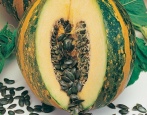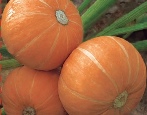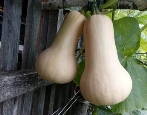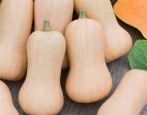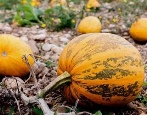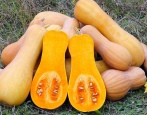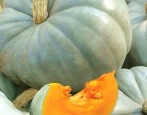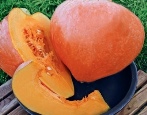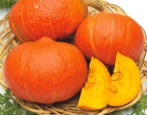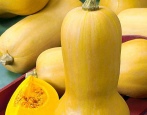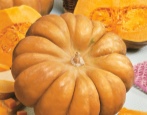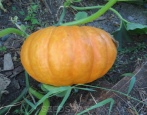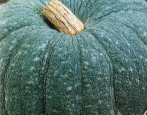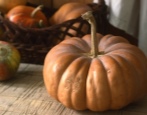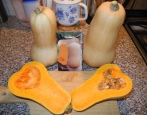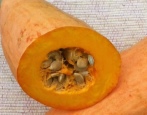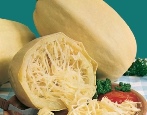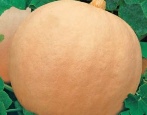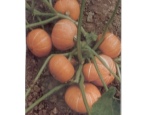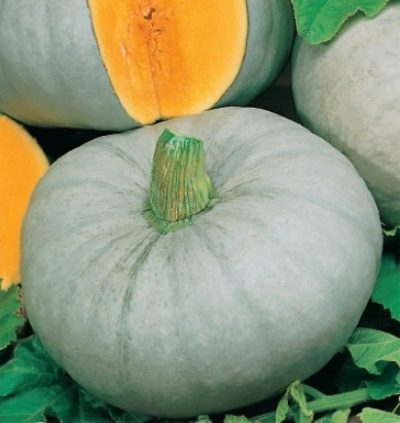
- Authors: Dyutin K.E., Smirnova L.G., Blashenkova T.I.
- Year of approval: 1996
- Growth type: medium power
- Leaf shape: reniform
- Leaf color: green
- The form: flat-round
- Weight, kg: 2,5-3,0
- Coloration: light gray, with pale pink spots on some fruits
- Bark: medium, woody
- Color of the pulp: bright orange
This is not to say that the pumpkin is universally loved. And yet it is very popular in rural areas as a fodder crop, and in summer cottages it is not such a rare guest. Modern selection has made it a completely acceptable product with a fruity taste and a wonderful aroma, but there is no need to talk about the benefits of pumpkin. In this it is difficult for her to find competitors.
Breeding history
The authorship of the unpretentious Kroshka variety with excellent taste and aroma belongs to K. E. Dyutin and L. G. Smirnova. Breeders carried out work at the All-Russian Research Institute of Irrigated Vegetable and Melon Growing, located in the Astrakhan Region, back in the 80s of the last century. The variety was registered in the State Register of the Russian Federation in 1996. The variety is adapted for the Lower Volga and Far Eastern regions.
Description of the variety
The crumb is intended for growing in open or protected ground, it is characterized by unpretentiousness, strong immunity and high resistance to attacks of insect pests.
The variety has many positive qualities:
- excellent indicators of yield, taste and aroma;
- strong immunity, optimal size, long-term keeping quality;
- the possibility of transportation over long distances;
- the admissibility of mechanized harvesting;
- growing on an industrial scale.
The disadvantages include the possibility of damage by powdery mildew. Some gardeners consider the small size of the fruit to be a minus, but this statement is controversial. Many people grow pumpkin for their own consumption, then large-fruited is far from always convenient: a dish from one fruit has already been cooked, but there is still a lot of pulp.
Characteristics of the appearance of plants and fruits
The crumb belongs to the category of climbing varieties, differs in average development power. Long lashes are covered with large kidney-shaped green leaves, the woody hard bark of the fruit has a light gray color with a bluish tint, sometimes with pinkish streaks on the surface. The shape of the fruit is flat-round, the texture is smooth, superficial.
The internal structure of the pumpkin consists of three dense planets with closed-type seed nests. Large, elongated-oval seeds are yellow, their amount is 1.2% of the total mass of bright orange, dense, brittle and slightly juicy pulp. Composition: dry matter - 16.2%, sugar - 9.2%, carotene - 12.1 mg per 100 g of raw matter. Thanks to the thick bark, the fruits are stored until March.
Purpose and taste
The pulp of the variety is characterized as very sweet, without fibers and viscosity. Tasters highly appreciate the taste of pumpkin, in addition, it has a surprisingly pleasant aroma with distinct melon notes. The crumb is used in cooking for making jams, jams and candied fruits, cereals and mashed soups. It is great in baked goods and even marinated.
Ripening terms
Pumpkin belongs to the mid-late category: on average, 119-128 days pass from germination to harvest. The crop is harvested from mid-summer to September.
Yield
The variety has high yield rates: from 217 to 384 kg / ha.
Growing and care
Growing pumpkin is possible both in seedling and non-seedling methods, both in the open field and in greenhouses.It is impractical to occupy greenhouse areas with a long-growing crop, for this there are plants that need it more. In the middle lane, Crumb is easier to grow in seedlings. This ensures that it will not be damaged by sudden frosts.
Sowing for seedlings is carried out in April. If cultivation is to be carried out by direct sowing in the open field, then this happens in the last days of May, at the beginning of June. It is advisable to pre-soak the seeds and even germinate. The optimal distance between the roots is 60 centimeters, the sowing depth is 3-5 cm. The pumpkin loves good lighting, so a sunny site is chosen for it. For proper development, it is necessary to take care of crop rotation. The best predecessors are potatoes and tomatoes, peppers and eggplants.
To grow seedlings, pre-soaked or already hatched seeds are laid out in glasses with nutritious soil and covered with a layer of earth up to 5 cm on top. Young plants with 3-4 leaves can be transplanted to a permanent place. Some gardeners are planted with 2-3 leaves, but such greens are still too weak and can die from a sharp change in climatic conditions. The land is dug up on the site, freed from the roots, fertilized with organic matter (humus, compost), wood ash is added. In addition to these preparations, the following is introduced directly into the hole:
- superphosphate - 60 g;
- ammonium nitrate - 30 g;
- potash fertilizers - 30 g.
Further care of the crop consists in regular watering, weeding and loosening.
Disease and pest resistance
The crumb has excellent immunity, which greatly facilitates the gardener's task - to grow a strong plant and get a good harvest. Pumpkin shows stable resistance to most diseases such as anthracnose. However, it can be affected by powdery mildew in an unfavorable summer. Pests do not show interest in the plant. To combat powdery mildew, fungicides are used.
